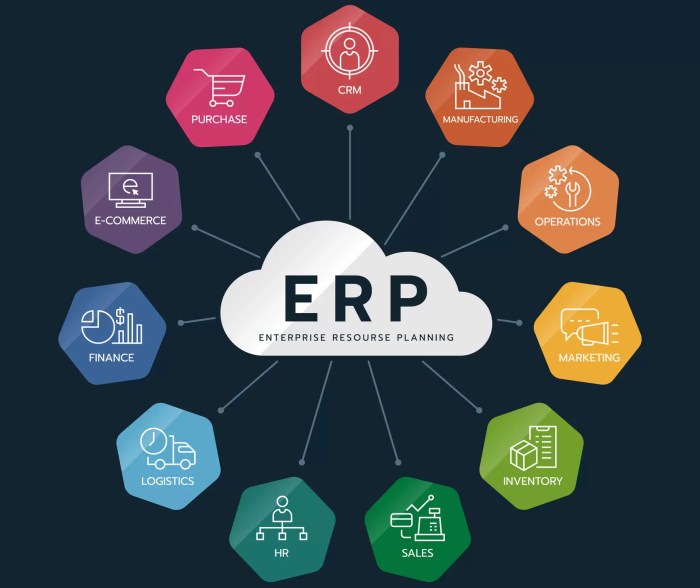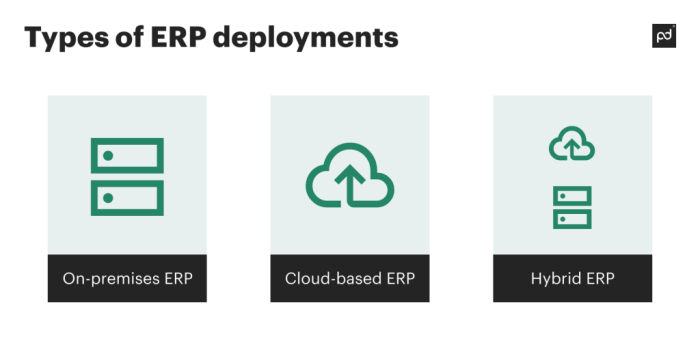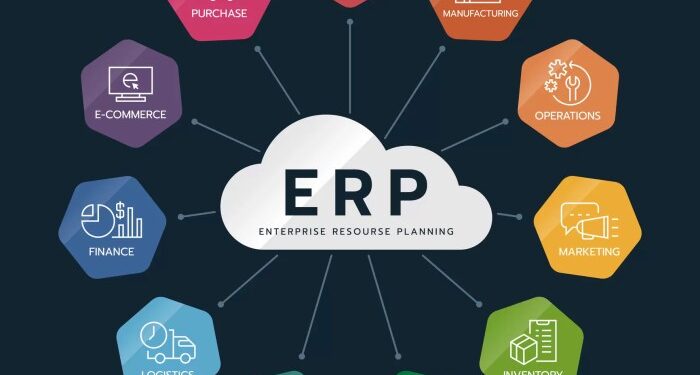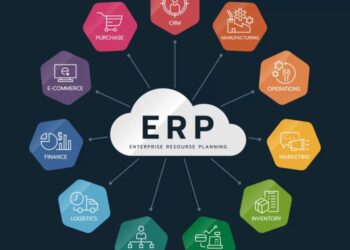Embark on a journey into the world of ERP deployment, where businesses revolutionize their operations with cutting-edge technology and streamlined processes. From planning to maintenance, this comprehensive guide explores every aspect of ERP deployment with insights and strategies to ensure success.
Introduction to ERP Deployment

Enterprise Resource Planning (ERP) is a software system that integrates and manages core business processes, such as finance, human resources, inventory, supply chain, and customer relationship management, in a centralized database.
ERP deployment refers to the process of implementing and setting up an ERP system within an organization. It is crucial for businesses looking to streamline operations, improve efficiency, and enhance decision-making processes.
Significance of ERP Deployment
- Streamlining Processes: ERP deployment helps in automating and integrating various business processes, leading to increased efficiency and productivity.
- Enhanced Data Visibility: By centralizing data in one system, ERP deployment provides real-time insights and visibility into the organization's performance.
- Improved Decision-making: With accurate and up-to-date information available through ERP systems, businesses can make informed decisions quickly.
Challenges Faced During ERP Deployment
- Resistance to Change: Employees may resist adapting to new processes and systems, leading to challenges in ERP implementation.
- Data Migration Issues: Transferring data from legacy systems to the new ERP system can be complex and time-consuming, often resulting in data integrity issues.
- Customization Complexity: Customizing the ERP system to meet specific business requirements can be challenging and may lead to delays in deployment.
Planning for ERP Deployment
Strategic planning is crucial before deploying an ERP system as it sets the foundation for a successful implementation. It involves assessing the organization's needs, defining goals, and outlining the steps necessary to achieve them.
Importance of Strategic Planning
Before diving into ERP deployment, organizations need to conduct a thorough analysis of their current processes, systems, and challenges. This will help in identifying the gaps that the ERP system needs to address and ensure a smooth transition.
Key Considerations for Selecting an ERP System
- Scalability: Ensure the ERP system can grow with the organization's needs.
- Customization: Look for a system that can be tailored to specific business requirements.
- Integration: Choose a system that seamlessly integrates with existing software and applications.
- User-Friendly Interface: Select an ERP system that is intuitive and easy for employees to adapt to.
- Vendor Support: Consider the level of support provided by the ERP vendor post-implementation.
Role of Project Manager
The project manager plays a critical role in planning ERP deployment by overseeing the project from start to finish. Their responsibilities include coordinating with different teams, managing timelines, and ensuring that the project stays within budget. A skilled project manager can help mitigate risks and ensure a successful ERP implementation.
Implementation Process of ERP Deployment
Implementing an ERP system involves several key steps to ensure a successful transition. From planning to execution, each phase plays a crucial role in the overall deployment process.
Steps Involved in Implementing an ERP system
- Assessment and Planning: Evaluate current systems and processes to identify goals and requirements for the new ERP system.
- Selection of ERP Vendor: Choose a reputable vendor that aligns with your business needs and budget.
- Customization and Configuration: Tailor the ERP system to fit your organization's specific workflows and requirements.
- Testing and Training: Conduct thorough testing to ensure the system functions properly and provide comprehensive training to users.
- Go-Live and Support: Transition to the new ERP system and provide ongoing support to address any issues that may arise.
Best Practices for Data Migration during ERP Deployment
- Cleanse and Validate Data: Ensure data accuracy by removing duplicates, errors, and inconsistencies before migration.
- Backup Data: Create backups of all data to prevent loss during the migration process.
- Use Data Migration Tools: Utilize specialized tools to streamline the data migration process and reduce the risk of errors.
- Perform Trial Runs: Conduct trial migrations to identify and address any issues before the final migration.
- Monitor Data Migration: Supervise the migration process closely to track progress and address any issues promptly.
Ensuring a Smooth Transition to the New ERP System
- Change Management: Communicate with stakeholders and employees to prepare them for the transition and address any concerns.
- Provide Continuous Support: Offer ongoing support and training to help users adapt to the new system effectively.
- Monitor Performance: Keep track of system performance post-deployment to identify areas for improvement and optimize processes.
- Seek Feedback: Gather feedback from users to understand their experience with the new ERP system and make necessary adjustments.
Training and Change Management in ERP Deployment
Training employees for ERP system adoption and implementing effective change management strategies are crucial components of a successful ERP deployment. Let's delve into the significance of training, strategies for change management, and tips for effective communication with stakeholders.
Significance of Training for ERP System Adoption
Training employees on how to use the new ERP system is essential for successful adoption. Proper training ensures that employees understand the functionalities of the system, can effectively utilize it in their daily tasks, and feel confident in navigating through the software.
This leads to increased efficiency, productivity, and overall satisfaction with the new system.
- Provide comprehensive training sessions covering all aspects of the ERP system.
- Offer hands-on training to allow employees to practice using the system in a simulated environment.
- Provide ongoing support and resources for employees to refer back to after training sessions.
Strategies for Change Management during ERP Deployment
Change management is crucial during ERP deployment to ensure a smooth transition for employees
. It involves preparing employees for the changes that come with implementing a new system, addressing resistance, and fostering a positive attitude towards the change.- Communicate early and often about the upcoming changes and the reasons behind them.
- Involve employees in the decision-making process and listen to their concerns.
- Provide training and support to help employees adapt to the new system and processes.
- Celebrate small wins and milestones to keep employees motivated throughout the deployment.
Tips for Effective Communication with Stakeholders
Effective communication with stakeholders is key to a successful ERP deployment. Clear and transparent communication helps build trust, manage expectations, and ensure alignment between all parties involved in the deployment process.
- Establish a communication plan outlining key messages, channels of communication, and frequency of updates.
- Provide regular updates on the progress of the deployment and any changes in timelines or milestones.
- Encourage open feedback and communication from stakeholders to address any concerns or issues promptly.
- Tailor communication to different stakeholder groups, ensuring that the information is relevant and understandable to each group.
Testing and Quality Assurance in ERP Deployment
Testing and quality assurance play a crucial role in the successful deployment of an ERP system. It helps in ensuring that the system functions as intended, meets the business requirements, and is free from errors and issues.
Types of Testing in ERP Implementation
There are several types of testing that are essential during the ERP implementation process:
- Unit Testing: This involves testing individual components or modules of the ERP system to ensure they work correctly.
- Integration Testing: This tests how well the different modules of the ERP system work together and integrate with each other.
- System Testing: This tests the entire ERP system as a whole to ensure it meets the business requirements and functions properly.
- User Acceptance Testing: This involves testing the ERP system with end-users to ensure it meets their needs and is user-friendly.
Strategies for Quality Assurance
Ensuring quality assurance in the ERP system post-deployment is essential for its long-term success. Here are some strategies to achieve this:
- Regular Monitoring: Continuously monitor the ERP system to identify any issues or areas for improvement.
- Training and Support: Provide ongoing training and support to end-users to ensure they are using the system effectively.
- Feedback Mechanisms: Establish feedback mechanisms to gather input from users and stakeholders to make necessary adjustments and improvements.
- Regular Updates and Maintenance: Keep the ERP system up to date with regular updates and maintenance to ensure optimal performance.
Maintenance and Support After ERP Deployment
After the successful deployment of an ERP system, it is crucial to ensure ongoing maintenance and support to keep the system running smoothly and to address any issues that may arise. This phase is essential to maximize the benefits of the ERP system and to continuously improve its performance.
Best Practices for Troubleshooting Common Issues
- Regularly monitor system performance and conduct routine checks to identify any potential issues.
- Establish a dedicated support team with expertise in the ERP system to address and resolve issues promptly.
- Maintain open communication channels with end-users to gather feedback and address any user-related issues.
- Document common problems and their solutions to create a knowledge base for future reference.
- Regularly update the ERP system with patches and upgrades to ensure optimal performance and security.
Role of Continuous Improvement
Continuous improvement plays a vital role in optimizing the ERP system post-deployment to meet evolving business needs and to drive efficiency. It involves:
- Regularly assessing the performance of the ERP system and identifying areas for enhancement.
- Implementing feedback from end-users to make necessary adjustments and improvements to the system.
- Conducting regular training sessions to educate users on new features and functionalities of the ERP system.
- Collaborating with key stakeholders to align the ERP system with changing business objectives and strategies.
- Monitoring key performance indicators to measure the impact of continuous improvement efforts on system performance.
Final Thoughts

In conclusion, ERP deployment is a transformative process that requires meticulous planning, effective training, and ongoing support. By following best practices and embracing change, businesses can unlock the full potential of their ERP systems and drive growth and efficiency.
Question & Answer Hub
What are some common challenges faced during ERP deployment?
Common challenges include data migration issues, resistance to change from employees, and integration problems with existing systems.
Why is training employees important for ERP system adoption?
Training ensures that employees can effectively use the new ERP system, maximizing its benefits and improving overall productivity.
What types of testing are involved in ERP implementation?
Testing types include unit testing (testing individual components), integration testing (testing how components work together), and user acceptance testing (ensuring it meets user requirements).
How can quality assurance be ensured in the ERP system post-deployment?
Quality assurance can be ensured through regular audits, feedback mechanisms, and continuous monitoring of system performance and user feedback.
Why is ongoing maintenance and support crucial after ERP deployment?
Ongoing maintenance and support are essential to address any issues that may arise, implement system updates, and ensure the ERP system continues to meet business needs.







![Best Construction ERP Software [2024 Edition]](https://health.bandungnews.id/wp-content/uploads/2025/10/Top-10-Best-Construction-ERP-Software-to-Use-in-2024-1-120x86.jpg)



